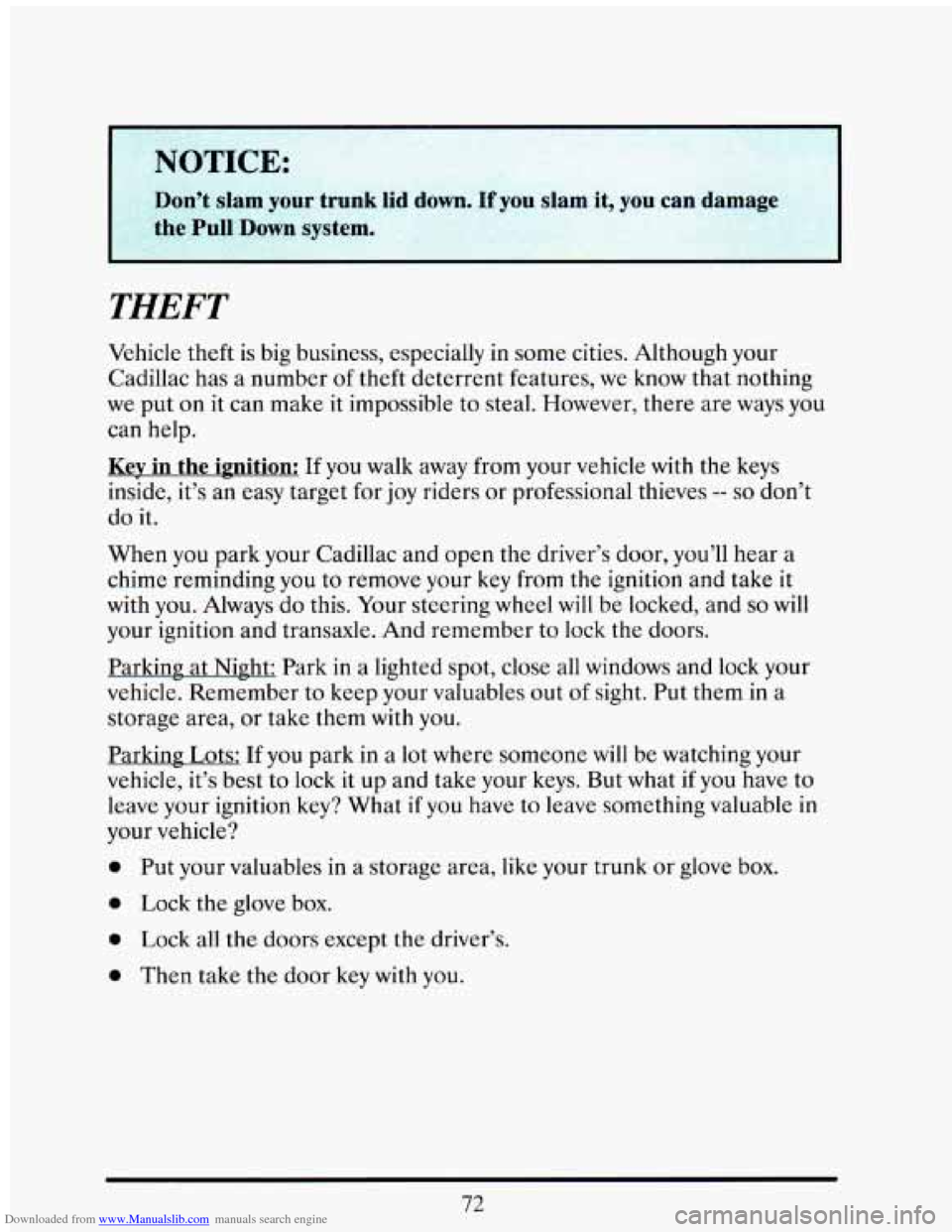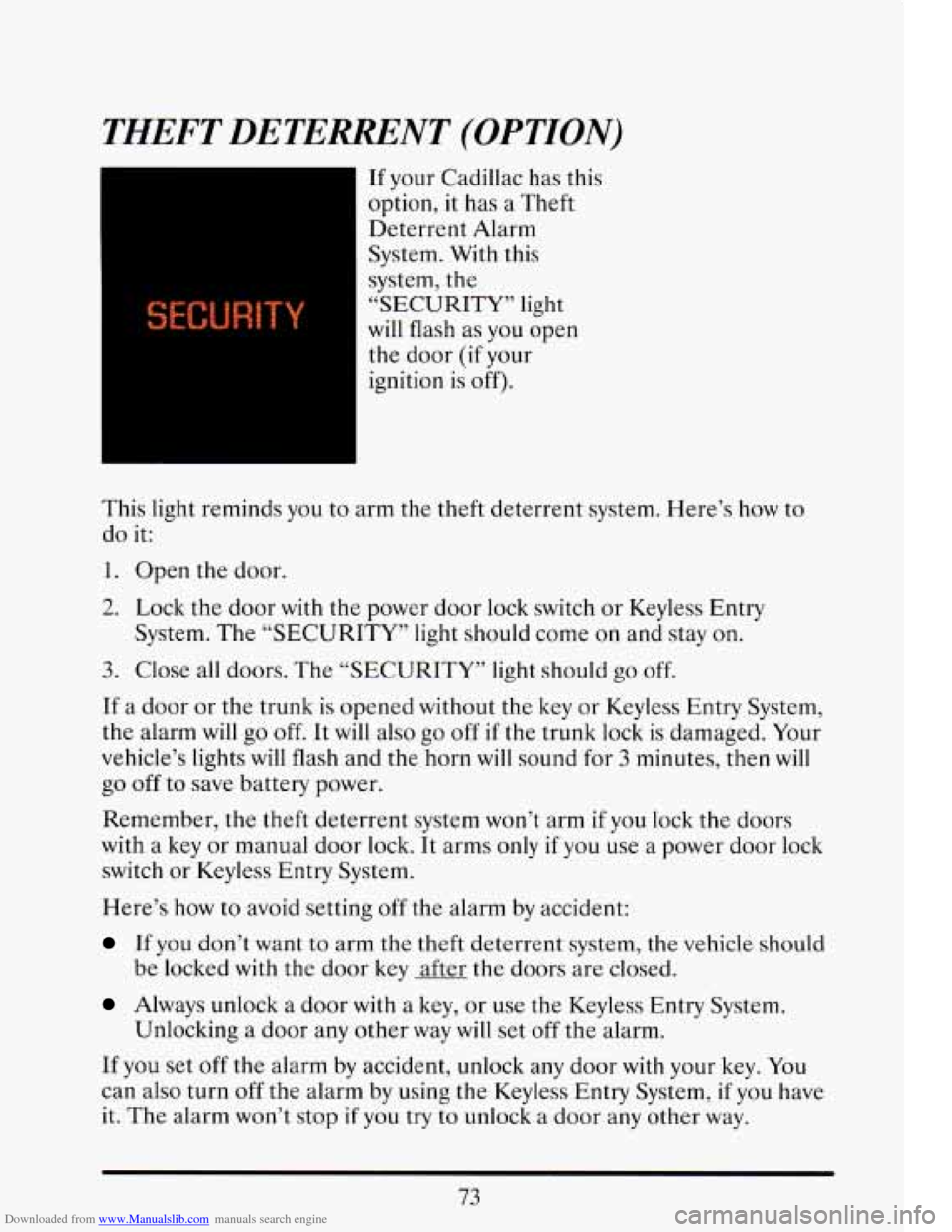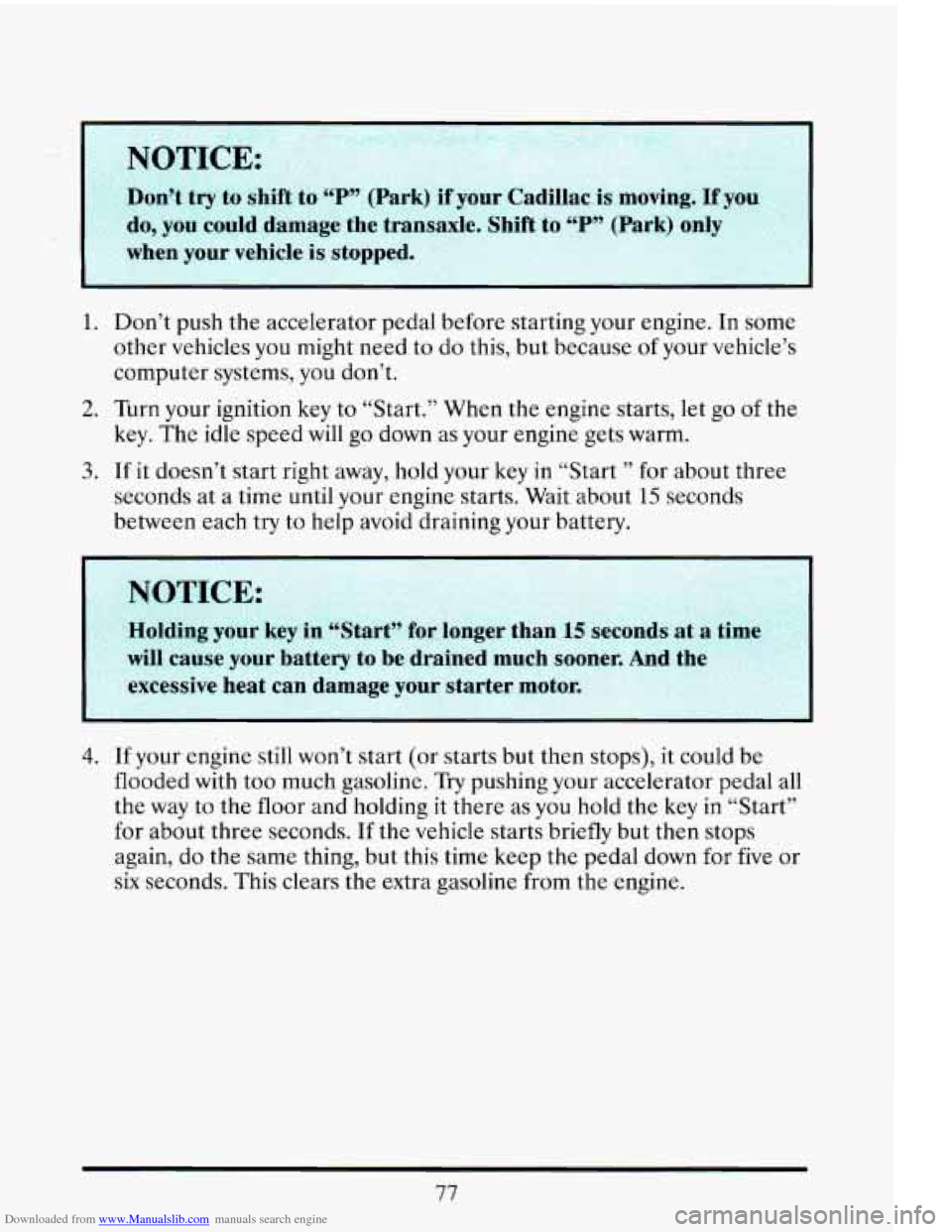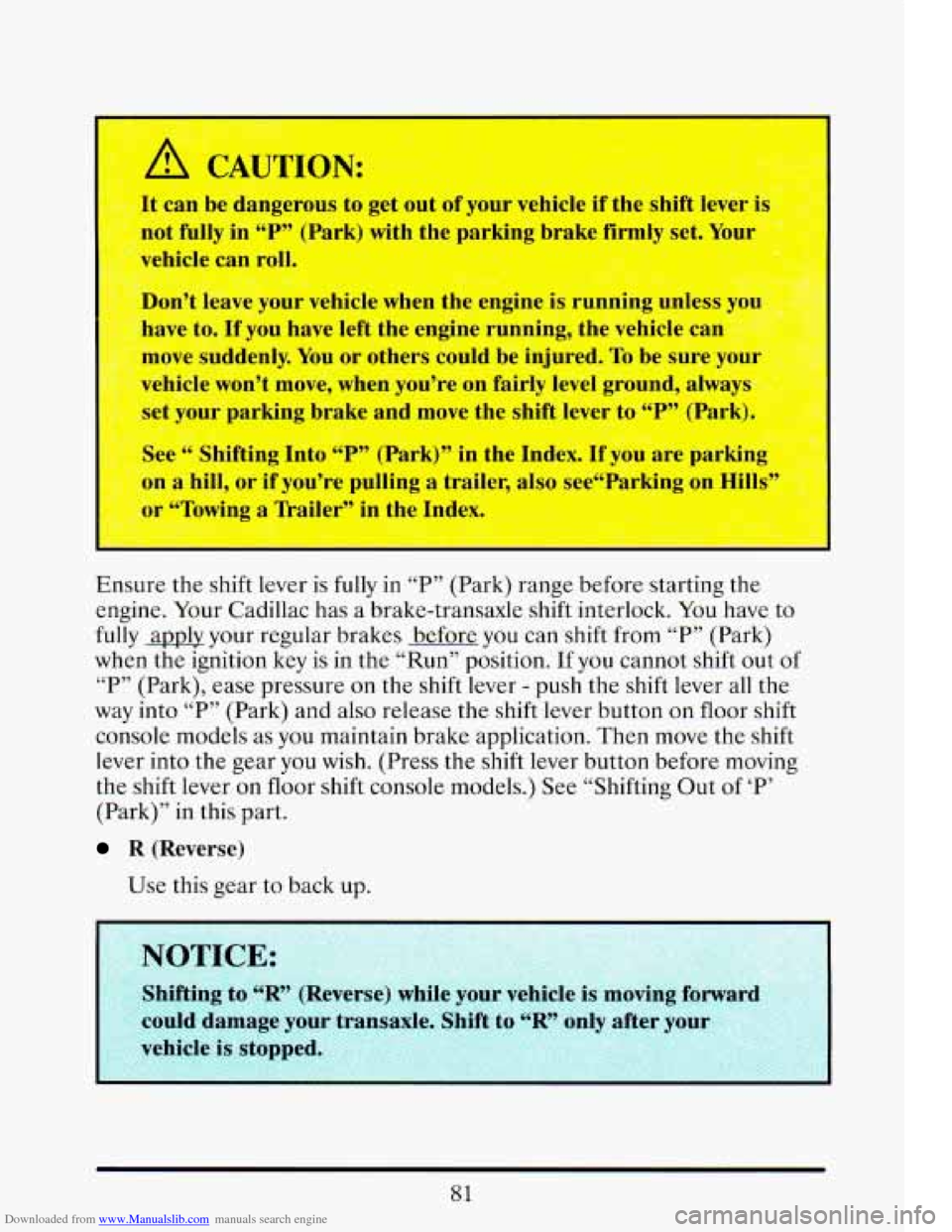1993 CADILLAC ELDORADO ignition
[x] Cancel search: ignitionPage 86 of 398

Downloaded from www.Manualslib.com manuals search engine 1 NOTICE:
Don’t slam your trunk lid down. If you slam it, vou can damage
I
THEFT
Vehicle theft is big business, especially in some cities. Although your
Cadillac has a number of theft deterrent features, we know that nothing
we put on
it can make it impossible to steal. However, there are ways you
can help.
Key in the ipition: If you walk away from your vehicle with the keys
inside, it’s an easy target for joy riders or professional thieves
-- so don’t
do it.
When you park your Cadillac and open the driver’s door, you’ll hear a
chime reminding you
to remove your key from the ignition and take it
with you. Always do this. Your steering wheel will be locked, and so will
your ignition and transaxle. And remember to lock the doors.
Parking at Night: Park
in a lighted spot, close all windows and lock your
vehicle. Remember to keep your valuables out
of sight. Put them in a
storage area, or take them
with you.
Parking Lots: If
you park in a lot where someone will be watching your
vehicle, it’s best to lock
it up and take your keys. But what if you have to
leave your ignition key? What
if you have to leave something valuable in
your vehicle?
0 Put your valuables in a storage area, like your trunk or glove box.
0 Lock the glove box.
0 Lock all the doors except the driver’s.
0 Then take the door key with you.
72
Page 87 of 398

Downloaded from www.Manualslib.com manuals search engine THEFT DETERRENT (OPTION)
If your Cadillac has this
option, it has a Theft
Deterrent Alarm System. With this
system, the
“SECURITY” light
will flash as you open
the door (if your
ignition is off).
This
light reminds you to arm the theft deterrent system. Here’s how to
do it:
1. Open the door.
2. Lock the door with the power door lock switch or Keyless Entry
System. The
“SECURITY” light should come on and stay on.
3. Close all doors. The “SECURITY” light should go off.
If a door or the trunk is opened without the key or Keyless Entry System,
the alarm
will go off. It will also go off if the trunk lock is damaged. Your
vehicle’s lights will flash and the horn will sound for 3 minutes, then will
go off to save battery power.
Remember, the theft deterrent system won’t arm
if you lock the doors
with a key or manual door lock.
It arms only if you use a power door lock
switch or Keyless Entry System.
Here’s
how to avoid setting off the alarm by accident:
If you don’t want to arm the theft deterrent system, the vehicle should
be locked with the door key after the doors are closed.
Always unlock a door with a key, or use the Keyless Entry System.
If you set off the alarm by accident, unlock any door with your key. You
can also turn
off the alarm by using the Keyless Entry System, if you have
it. The alarm won’t stop if you try to unlock a door any other way.
Unlocking
a door
any other way will set off the alarm.
73
Page 88 of 398

Downloaded from www.Manualslib.com manuals search engine How to Test The Alarm
0 Roll down your window and lock your vehicle using the power door
Reach in and unlock the door using the manual lock, and open the
If the alarm does not sound when it should, check to see if the horn
works. The horn fuse may
be blown. To replace the fuse, see “Fuses and
Circuit Breakers” in the Index.
lock
or the Keyless Entry System.
door. The horn
will sound and your headlights will flash.
To reduce the possibility of theft, always arm the theft deterrent system
when leaving your vehicle.
PASS-KEY IIm
Your vehicle is equipped with the PASS-Key I1 TM (Personalized
Automotive Security System) theft deterrent system. PASS-Key
I1 TM is a
passive theft deterrent system. This means
you don’t have to do anything
different to arm
or disarm the system. It works when you insert or remove
the key from the ignition. PASS-Key
TM uses a resistor pellet in the
ignition key that matches
a decoder in your vehicle.
When the PASS-Key
TI TM system senses that someone is using the wrong
key, it shuts down the vehicle’s starter
and fuel systems. For about three
minutes, the starter won’t work and fuel won’t go to the engine.
If
someone tries to start your vehicle again or uses another key during this
time, the vehicle will not start. This discourages someone from randomly
trying different keys with different resistor pellcts in
an attempt to make a
match.
The ignition key must
be clean and dry before it’s inserted in the ignition
or the engine may not start.
If the engine does not start and the
“SECURITY” light comes on, the key may be dirty
or wet. Turn the
ignition
off.
If you’re ever driving and the “SECURITY” light comes on and
continues to flash, you get the “PASS-KEY MALFUNCTION” message
and the “STARTING DISABLED” message appears, you
will be able to
restart your engine
if you turn it off. Your PASS-Key TI TM system,
however,
is not working properly and must be serviced bylour Cadillac
dealer. Your vehicle
is not protected by the PASS-Key I1 system.
74
Page 89 of 398

Downloaded from www.Manualslib.com manuals search engine If you lose or damage a PASS-Key I1 TM ignition key, see your Cadillac
dealer or a locksmith who can service PASS-Key
I1 TM to have a new key
made.
IGNITION KEY POSITIONS
This lock gives you five
different positions.
75
Before you put the key in, your ignition will be in the “LOCK” position.
This position locks your ignition, steering wheel and transaxle. It’s an
anti-theft feature.
Page 90 of 398

Downloaded from www.Manualslib.com manuals search engine The other positions let you perform these functions:
ACC: Accessory lets you use things like the radio and the windshield
wipers when the engine
is off. To get into “ACC”, push in the key and turn
it toward you. Your steering wheel will remain locked, just
as it was
before you inserted the key.
OFF This position lets you turn off the engine but still turn the steering
wheel. It doesn’t lock the steering wheel like
“Lock.” Use “Off” if you
must have your car in motion while the engine is off (for example, if your
car
is being pushed).
RUN: This
is the position for driving.
START
This starts your engine.
r
NOTICE:
If your key seems stuck in ‘ xk and you can’t turn it, be sure
it
is all the way in. If it is, then turn the steering wheel left and
right while
you turn the key hard. But turn the key only with
your hand. Using
a tool to force it could break the key or the
ignition swi’
’1. If none of this w--ks, then your vehicle 3
servi cc
STARTING YOUR ENGINE
Engines start differently. The 8th digit of your Vehicle Identification
Number
(VIN) shows the code letter or number for your engine. You will
find the VIN at the top left
of your instrument panel. (See “Vehicle
Identification Number” in the Index.) Follow the proper steps to start the
engine.
Move your shift lever to
“P” (Park) or “N” (Neutral). Your engine won’t
start in any other position
-- that’s a safety feature. To restart when you’re
already moving, use “N” (Neutral) only.
76
Page 91 of 398

Downloaded from www.Manualslib.com manuals search engine 1. Don’t push the accelerator pedal before starting your engine.\
In some
other vehicles you might need
to do this, but because of your vehicle’s
computer systems, you don’t.
2. Turn your ignition key to “Start.” When the engine starts, let go of the
key. The idle speed
will go down as your engine gets warm.
3. If it doesn’t start right away, hold your key in “Start ” for about three
seconds at a time until your engine starts. Wait about
15 seconds
between each try to help avoid draining
your battery.
.. -. ..
Holding your key in “Start” for longer than 1
excessive heat can damage your starter motor. . .. .
4. If your engine still won’t start (or starts but then stops), it could be
flooded with too much gasoline.
Try pushing your accelerator pedal all
the way to the floor and holding it there as you hold the key in “Start”
for about three seconds.
If the vehicle starts briefly but then stops
again, do
the same thing, but this time keep the pedal down for five or
six seconds. This clears the extra gasoline from the engine.
77
Page 95 of 398

Downloaded from www.Manualslib.com manuals search engine vel le tan roll, $2-2.~
Don’t I enicle when the engine is runnmg unles
have
to. If you have left the engine running, the vehicle ca
move suddenly.
You or others could be injured. To be sure
vehicle won’t move, when you’re on
fairly level ground, alw
set your parking brake and move the shift lever to
“P” (Par
See “ snifting Into “P” (Park)” in the Index. 11 you are par
L a hill, or if you’re pulling a trailer, also see“Parking o
or “Towing a Trailer” in the Index.
-*- aq .: : - - . .. .h i-” .. .i T
..
Ensure the shift lever is fully in “P” (Park) range before starting the
engine. Your Cadillac has a brake-transaxle shift interlock. You have to
fully apply your regular brakes before
you can shift from “P” (Park)
when the ignition key is in the “Run” position.
If you cannot shift out of
“P” (Park), ease pressure on the shift lever - push the shift lever all the
way into “P” (Park) and also release the shift lever button on floor shift
console models as you maintain brake application. Then move the shift
lever into the gear you wish. (Press the shift lever button before moving
the shift lever
on floor shift console models.) See “Shifting Out of ‘P’
(Park)” in this part.
R (Reverse)
Use this gear to back up.
81
Page 99 of 398

Downloaded from www.Manualslib.com manuals search engine To set the parking brake:
Hold the regular brake pedal down with your right foot. Push down the
parking brake pedal with your left foot. If the ignition
is on, the brake
system warnin? light
will come on.
I-
I
When you move out
of “P” (Park) or “N”
(Neutral), if your
engine
is running,
your parking brake should go off.
If it
doesn’t, you have a
parking brake
problem and should have it fixed.
In the
meantime,
you can
still release your
parking brake. Just
pull on the manual
release lever, as
shown.
I
3me-q 5::- &*ZL !My& se-4
A CAUTION: . -- .
If your hand or arm is in the way of thi’pedal, you could be -,::+ -+..:
hurt. The pedal springs back quickly. Keep your hand and arm !+. ,--,:“:
away when you use 1 ! manual release lever. :,F
.L- ..
-.7 7 .--.. , - ., .I .. - .>, _. .- : - .?f I - - .. - --. . ’-: .:. ..:= . ’. + .? .. .
NOTICE
Driving with the parking lake on can cause ~UL- rear bra,
overheat.
You mav have to replace them- and vou could also
,.*age ~ ~. .: . ~ i nther pal vnur vfihicle.
L .~-:’? . - I . - . i i .. ~
85